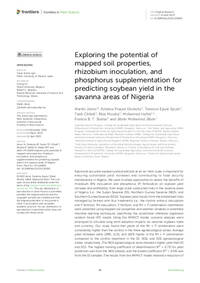Exploring the potential of mapped soil properties, rhizobium inoculation, and phosphorus supplementation for predicting soybean yield in the savanna areas of Nigeria

Authors:
Rapid and accurate soybean yield prediction at an on-farm scale is important for ensuring sustainable yield increases and contributing to food security maintenance in Nigeria. We used multiple approaches to assess the benefits of rhizobium (Rh) inoculation and phosphorus (P) fertilization on soybean yield increase and profitability from large-scale conducted trials in the savanna areas of Nigeria [i.e., the Sudan Savanna (SS), Northern Guinea Savanna (NGS), and Southern Guinea Savanna (SGS)]. Soybean yield results from the established trials managed by farmers with four treatments (i.e., the control without inoculation and P fertilizer, Rh inoculation, P fertilizer, and Rh + P combination treatments) were predicted using mapped soil properties and weather variables in ensemble machine-learning techniques, specifically the conditional inference regression random forest (RF) model. Using the IMPACT model, scenario analyses were employed to simulate long-term adoption impacts on national soybean trade and currency. Our study found that yields of the Rh + P combination were consistently higher than the control in the three agroecological zones. Average yield increases were 128%, 111%, and 162% higher in the Rh + P combination compared to the control treatment in the SS, NGS, and SGS agroecological zones, respectively. The NGS agroecological zone showed a higher yield than SS and SGS. The highest training coefficient of determination (R2 = 0.75) for yield prediction was from the NGS dataset, and the lowest coefficient (R2 = 0.46) was from the SS samples. The results from the IMPACT model showed a reduction of 10% and 22% for the low (35% adoption scenario) and high (75% adoption scenario) soybean imports from 2029 in Nigeria, respectively. A significant reduction in soybean imports is feasible if the Rh + P inputs are large-scaled implemented at the on-farm field and massively adopted by farmers in Nigeria.
